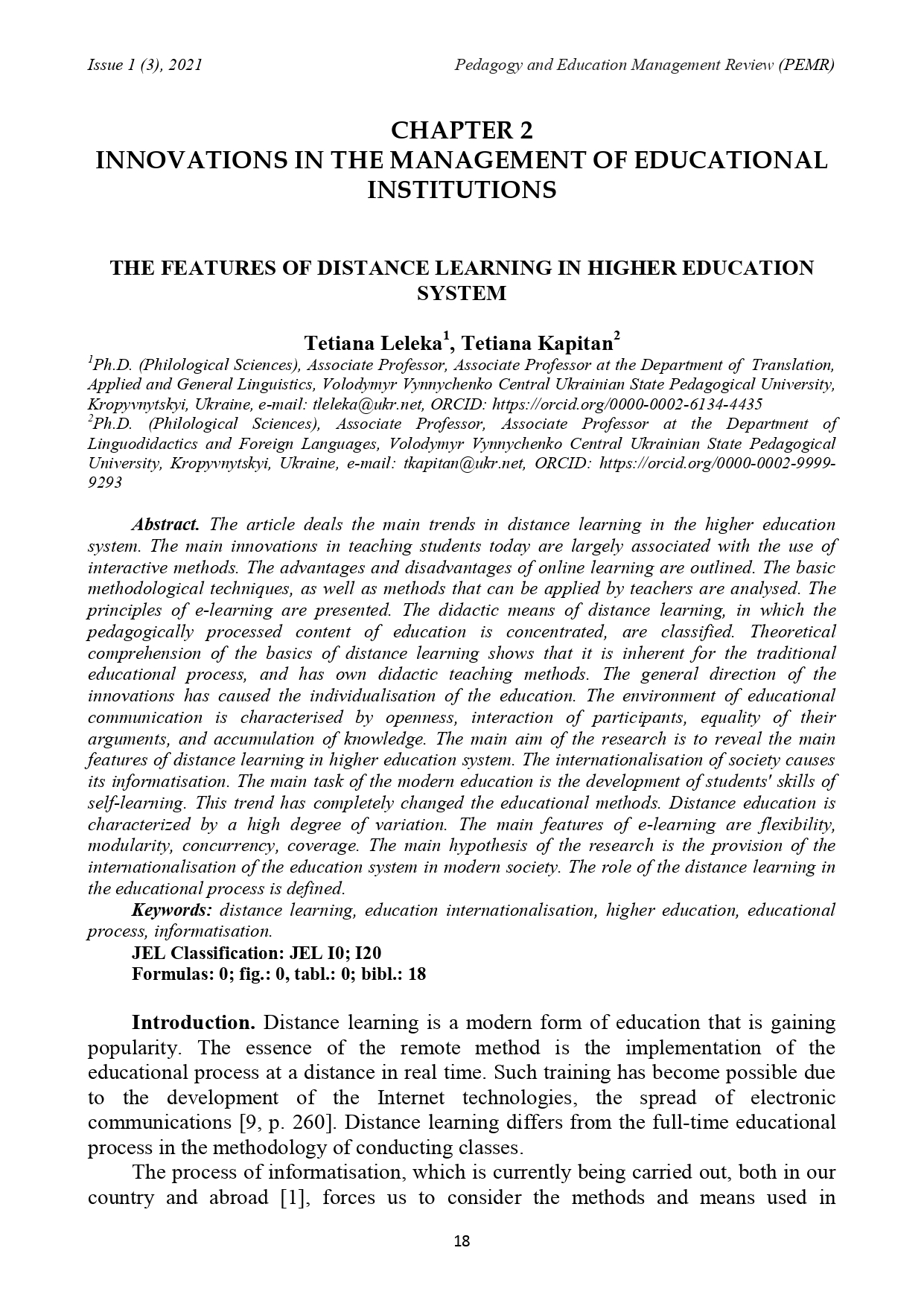THE FEATURES OF DISTANCE LEARNING IN HIGHER EDUCATION SYSTEM
DOI:
https://doi.org/10.36690/2733-2039-2021-1-18Keywords:
distance learning, education internationalisation, higher education, educational process, informatisationAbstract
The article deals the main trends in distance learning in the higher education system. The main innovations in teaching students today are largely associated with the use of interactive methods. The advantages and disadvantages of online learning are outlined. The basic methodological techniques, as well as methods that can be applied by teachers are analysed. The principles of e-learning are presented. The didactic means of distance learning, in which the pedagogically processed content of education is concentrated, are classified. Theoretical comprehension of the basics of distance learning shows that it is inherent for the traditional educational process, and has own didactic teaching methods. The general direction of the innovations has caused the individualisation of the education. The environment of educational communication is characterised by openness, interaction of participants, equality of their arguments, and accumulation of knowledge. The main aim of the research is to reveal the main features of distance learning in higher education system. The internationalisation of society causes its informatisation. The main task of the modern education is the development of students' skills of self-learning. This trend has completely changed the educational methods. Distance education is characterized by a high degree of variation. The main features of e-learning are flexibility, modularity, concurrency, coverage. The main hypothesis of the research is the provision of the internationalisation of the education system in modern society. The role of the distance learning in the educational process is defined.
Downloads
References
Baker, R. S. J. D., Mitrović, A., & Mathews, M. (2010, June). Detecting gaming the system in constraintbased tutors: User modeling, adaptation and personalization. In Lecture Notes in Computer Science, 267–278. Hawaii: HI.
Bosch, A. (1997). Interactive radio instruction: Twenty-three years of improving education quality. Washington, DC: World Bank Group.
Clark, R. A., & Jones, D. (2001). A comparison of traditional and online formats in a public speaking course. Communication Education 50(2), 109–124.
Commonwealth of Learning & Asian Development Bank (Eds.). (2008). Quality assurance in open and distance learning: A toolkit. Vancouver, BC: Commonwealth of Learning and Manila, Philippines: Asian Development Bank.
Dede, C., Clarke, J., Ketelhut, D., Nelson, B., & Bowman, C. (2005). Fostering motivation, learning, and transfer in Multi-User Virtual Environments. Paper presented at the American Educational Research Association Conference, Montréal, Canada.
Deslauriers, L., Schelew, E., & Wieman, C. (2011). Improved learning in a large-enrollment physics class. Science 332(6031), 862–864.
Gee, J. P. (2003). What video games have to teach us about learning and literacy. New York, NY: Palgrave.
Gee, J. P., & Shaffer, D. W. (2010). Looking where the light is bad: Video games and the future of assessment. (Epistemic Games Group Working Paper No. 2010-02) [PDF document]. Madison, WI: University of Wisconsin-Madison. Retrieved from http://epistemicgames.org/eg/wp-content/uploads/Looking-wherethe-light-is-bad-tr1.pdf
Haney, W., & Clarke, M. (2007). Cheating on tests: Prevalence, detection and implications for online testing. In E. Anderson and T. Murdock (Eds.), Psychology of academic cheating (pp. 255–288). Burlington, MA: Elsevier Academic Press.
Moon, B., Leach, J., & Stevens, M. P. (2005). Designing open and distance learning for teacher education in subSaharan Africa: A toolkit for educators and planners [PDF document]. Washington, DC: World Bank.
O’Dwyer, L. M., Masters, J., Dash, S., DeKramer, R. M., Humez, A., & Russell, M. (2010, June). E-learning for educators: Effects of online professional development on teachers and their students. Retrieved from http://www.bc.edu/research/intasc/PDF/EFE_Findings2010_Report.pdf
Shaffer, D. W. (2005). Epistemic games. Innovate: Journal of Online Education 1(6). Retrieved from http://www.nsuworks.nova.edu/cgi/viewcontent.cgi?article=1165&context=innovate
Shaffer, D. W., Squire, K. R., Halverson, R., & Gee, J. P. (2005). Video games and the future of learning. Phi Delta Kappan 87(2), 104–111.
Shaffer, D. W., & Resnick, M. (1999). “Thick” authenticity: New media and authentic learning. Journal of Interactive Learning Research 10(2), 195–215.
Squire, K. (2006). From content to context: Video games as designed experience. Educational Researcher 35(8), 19–29.
Squire, K., & Barab, S. (2004). Replaying history: Engaging urban underserved students in learning world history through computer simulation games. In Proceedings of the 6th International Conference on Learning Sciences ICLS ‘04. Los Angeles, CA: UCLA.
Teng, Y., & Allen, J. (2005). Using Blackboard in an educational psychology course to increase pre-service teachers’ skills and confidence in technology integration. Journal of Interactive Online Learning 3(4), 1–12.
Taylor, J. C. (1995). Distance education technologies: The fourth generation. Australian Journal of Educational Technology 11(2), 1–7. Retrieved from http://www.ascilite.org.au/ajet/ajet11/taylor.html






